♪ Music husband is brewing to ♪
Please join me and fellow Persian food bloggers as we celebrate the Iranian midsummer festival Tirgan with a virtual picnic. I am also thrilled to have Drew, aka Mr. Husband take the reins on this post. Because a summer picnic is never complete without a bottle of Husband’s Kombucha.
Kombucha – Fun With Bacteria
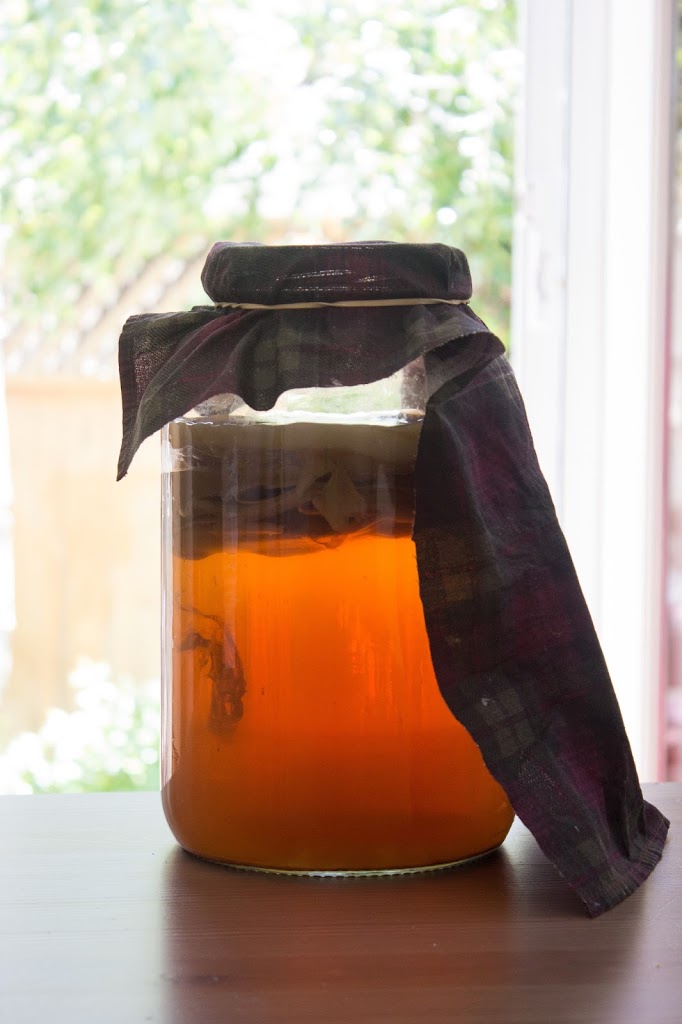
Three years ago a good friend of mine pulled me aside with a proposition. “Have you heard about kombucha? I think you’d like brewing it.” Now, this sounded like an odd endeavor. I knew this was some sort of fermented drink, most likely with floating parts to it. But to make my own? Brewing my own beer was more up my alley. Still, I heard her out, all with yelling children in the background, demanding our attention. I say this because the process was so simple to understand and implement, I could even process it while my attention was divided! I said yes, and next thing I knew I was on my way home with a SCOBY, floating in a sweet tea mixture. Thus began a 3-year odyssey of kombucha home-brewing.
I think the best part of this hobby, apart from the delicious, naturally effervescent and healthy beverage I make for the family each week, is the bragging rights that I actually do it. This is a strange and fascinating concept to so many. Kombucha is a relatively new product in western grocery stores. Many have seen the store-bought bottles and wondered to themselves what it was about. Or perhaps they have tried it, loved it, and are now shelling out up to $8 a bottle for it. Everyone I’ve spoken to about this wants to know the process, and strongly considers taking it on themselves. In fact, as my SCOBY has grown, I’ve been able to hand off sections of it to others for their own brewing.
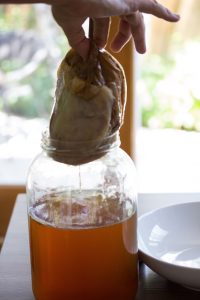
You might be wondering, what is this SCOBY he keeps talking about? SCOBY is an acronym for Symbiotic Culture Of Bacteria and Yeast. It can also be called “The Mother” as all the good stuff comes from it. The SCOBY will take the shape of its container, usually a jar. It will be round and disc-like, and as it grows it will form multiple discs, almost like floating pancakes. Eventually it will become too large, and you will need to separate some of these pancakes for giving away, or composting. I’m proud to say my SCOBY has many children now. I’ve given away extras to many friends for their own home brew, and have even auctioned off “kombucha starter kits” for our kids’ school!
Getting a SCOBY might have been the hardest part of getting started a few years back. You would need to know someone one who had one, or search the back-back pages of the classifieds. But nowadays they are all over the internet, and even big companies like Amazon and Williams-Sonoma are getting into the game. A simple search online for “buying a SCOBY” will yield many results, if you don’t have a personal connection.
As you read through this recipe, you will notice that 1 cup of sugar is used in the process. This may make one assume you’ll be consuming copious amounts of sugar. Not so! The sugar, when mixed with tea, serves as a food or fuel for the SCOBY, and the result is kombucha. By the time you drink it there is very little sugar left. Alcohol is another by-product of the brewing process. But again, no more than trace amounts.
Another wonderful part of kombucha-making is the ability to customize. After your first fermentation process, you can add a couple more days with fruit (lemon and ginger is a great combination) or juice fermentation (pomegranate juice is always great), which will greatly increase the flavor and enjoyment. One of my favorite flavors, and the one I share with you today, was inspired by the ever present bottle of rose water during Nowruz – Persian New Year. Strawberries, rose water and mint. Huge hit in our house.
Once you are up and running, the process only takes about 20 minutes per week. I like to set reminders on my phone so I know when it’s time to boil water, when to transfer the kombucha, and when to refrigerate my bottles.
I can’t emphasize enough the rewards of this home brew: my kids love it, my wife really loves it (she drinks most of it usually!), and everyone who comes to the house loves it too. It’s refreshing, pairs well with any meal (particularly Persian stews with rice, like my all-time favorite Loobia Polo), and it helps to contribute to a healthy amount of good bacteria in the gut. In this day and age of antibiotics being prescribed for just about any ailment, the importance of good bacteria cannot be over stressed.
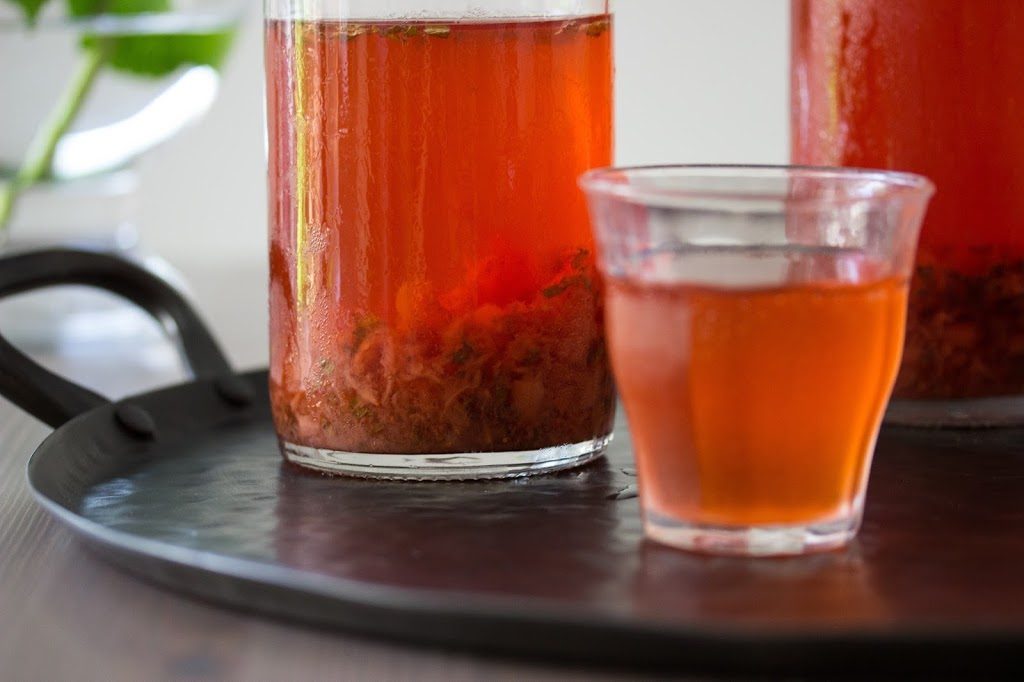
Fermenting from here? Naz has been after me to start a sourdough starter. In fact, she would like me to be the Resident Baker in our house. {editor’s interjection: Naz loves to delegate baking duties} And I’d certainly like to do that. Time is always an issue, of course. I’m very proud of Naz and her homemade batches of yogurt! But kombucha has proven to me that a very simple and enjoyable process can be slipped into an otherwise very busy lifestyle, and the benefits are tremendous.
Enjoy!
Sincerely,
Mr. Husband
STRAWBERRY, ROSE, AND MINT KOMBUCHA
What you need:
- 1 gallon glass jar (pickle jars with a wide mouth are great for this)
- Breathable Cloth to cover top, with rubber band to hold it in place
- 1 SCOBY (an acronym for Symbiotic Culture OF Bacteria and Yeast)
- 1 cup organic sugar (for your starter batch plus more to continue process)
- 4 organic black tea bags (for your first batch plus more to continue process)
- 3 sealable glass bottles
- Funnel (to pour liquids into the sealable glass bottles)
- Strainer (to separate any solids from your kombucha before drinking, although some people drink these too!)
- 6 large strawberries
- 2-4 fresh mint leaves
- 1 teaspoon rose water
- Organic juice of your choice, if you’re not using the strawberry, rose water, mint mix (or fresh fruits, or anything else you want to ferment with (ginger, lemon, etc))
Step 1:
- Boil 12 cups of water in a large pot.
- Add 1 cup of organic sugar. Stir until dissolved, about 1 minute. Turn the heat off.
- Add 4 tea bags of organic black tea
- Let the tea mixture cool to room temperature. Doing this in the evening before you go to bed is a good time, as you can then do step 2 in the morning.
- IMPORTANT NOTE: this sweet tea mixture is the food for your next batch of kombucha. Once you complete Step 2 below, you will use this mixture.
Step 2:
- With clean hands or with the help of a clean kitchen spoon, pull out your SCOBY from the tea mixture (now kombucha) and set aside in a separate bowl. Add a ½ cup of the kombucha to that bowl.
- Using 3 sealable glass bottles, add a finger’s width of your favorite organic juice (or fresh fruit of your choice) to each bottle. Use a funnel so you don’t spill. LESS IS MORE HERE! Stick to a finger’s width at the bottom of each jar, whether using juice or solids.
- For our strawberry/rose water/mint flavor, in a mortar and pestle muddle 6 strawberries, 2-4 mint leaves, and 1/2 teaspoon of rose water per glass bottle. Vary this depending on taste.
- Add the kombucha to each glass bottle, making it even between the three bottles. Store these away to ferment. Don’t put them in the fridge yet. They should sit out for 2 ½ days.
- Rinse out your now-empty kombucha jar with cold water. No soap, just a good rinse.
- Add your room-temperature sweet tea (from Step 1!) to the kombucha jar.
- Put your scoby and its ½ cup of kombucha back into the kombucha jar. Give it a gentle stir.
- Cover the jar with cloth and rubber band to hold it in place, and store in the dark for 7-10 days.
Step 3:
- After 2 ½ days, put your 3 bottles of kombucha juice in the fridge to stop the fermenting process and to chill it for drinking.
Step 4:
- Your kombucha juice is nicely chilled and ready for drinking! You can use a strainer when pouring your kombucha in case you don’t want any of the floating bits of scoby in there.
- The natural effervescence (bubbles) can vary from batch to batch; don’t be too concerned if one batch is a little more flat than another. It will come back! Some juices or fruit encourage this carbonation; some don’t.
Step 5:
- Step 5 is actually Step 1! Start the process over again once your kombucha brew has sat in the dark for at least 7 days.
Some other helpful points:
- If you’re going on vacation, don’t worry! Just brew your kombucha in the dark as you normally would. I’ve found that if it brews more than 14 days the taste is a little too vinegar-y for me. You can just start up the process again, as that scoby is pretty indestructible!
- Always keep the scoby in a glass container. Metal and plastic don’t work well. Real glass, nothing with lead in it.
- You will find that your scoby will increase in size, and separate! Once this happens you can either give an extra one to someone else, or compost it, or just throw it out. Some even eat it.
- Please share any new and exciting flavor combinations!


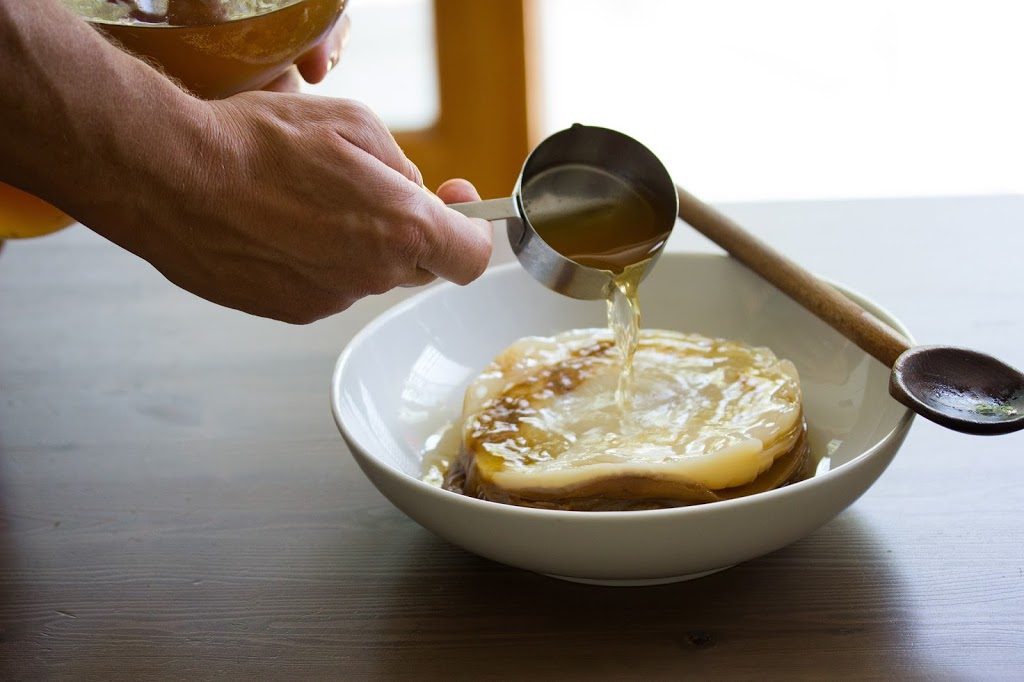
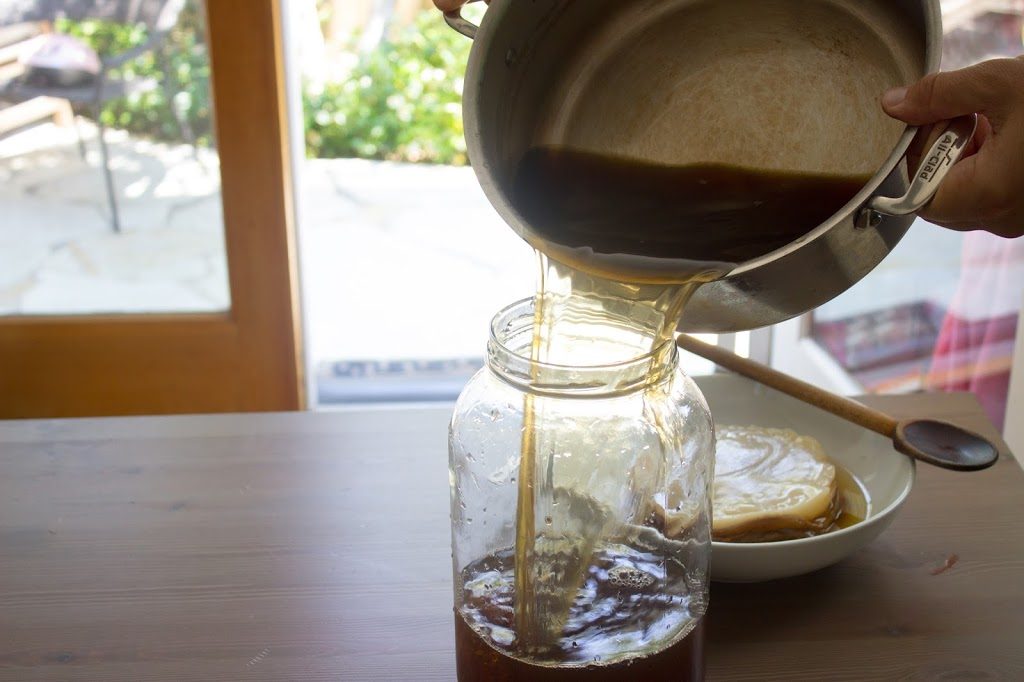
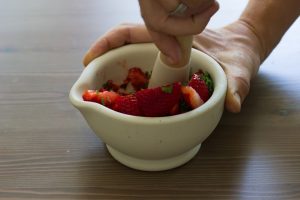
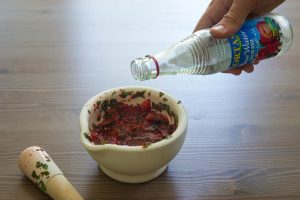
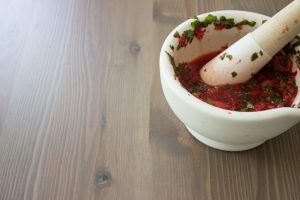
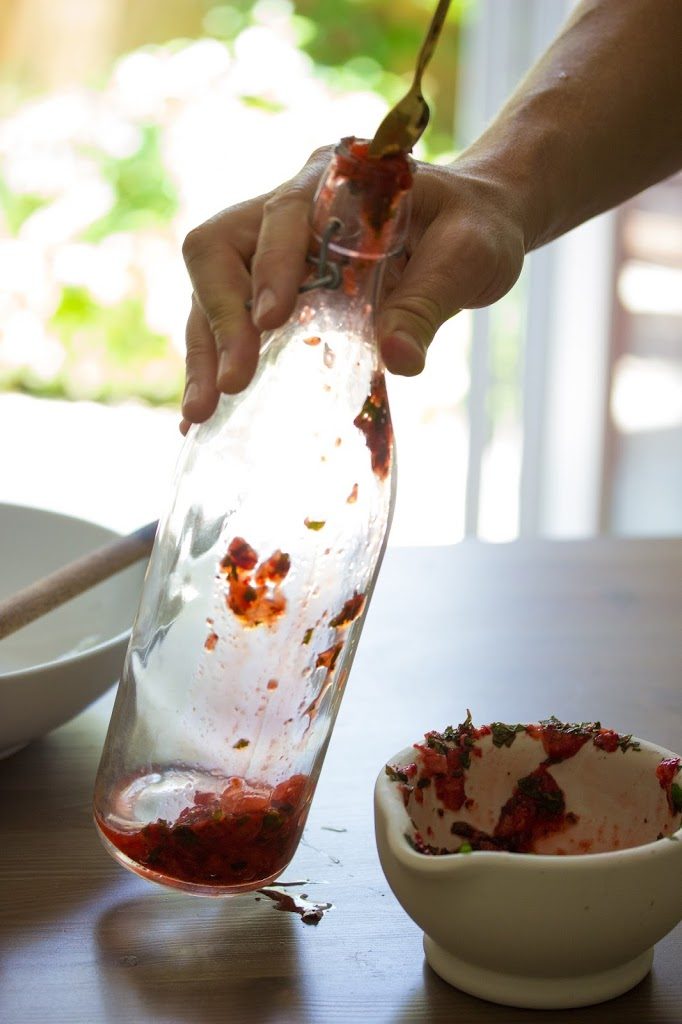
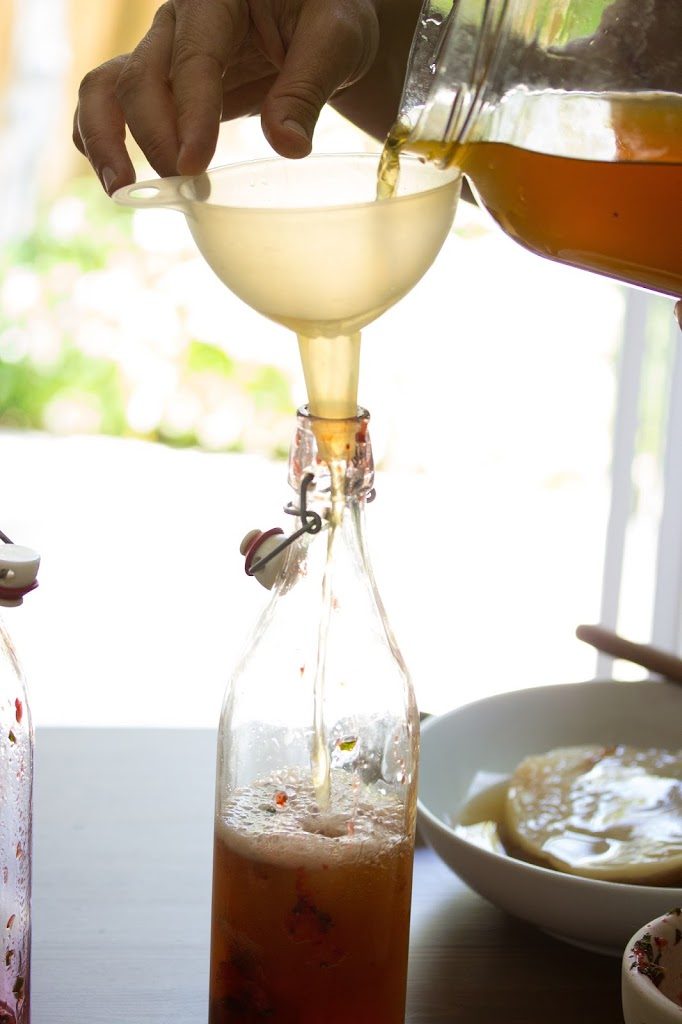
Comments (8)
What a great fusion of two cultures! I won't lie, I haven't tried kombucha yet. It kinda scares me! But this strawberry version definitely sounds amazing!
Laura, it's actually really easy. Let me know when you're ready and we'll hook you up with a SCOBY!
I feel like a celebrity that I've had the opportunity (and pleasure) of trying your kombucha, Drew. You know your stuff! So glad you've promised Naz you'll start baking sourdough. (You see where my loyalties are.)
Hehehe!
Growing up in Japan, I thought I knew what kombucha is. This is a whole different information I am learning. How interesting! Adding strawberries, rose water and mint really takes this drink to a different height! Fabulous! 😀
Ah! Now I'm committed aren't I?
Yes, I'm sure there are many ways to do this. This process has worked well for me. Results always vary from batch to batch, but the taste is always excellent!
That SCOBY is getting big again!